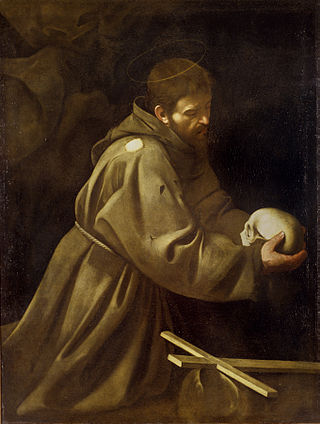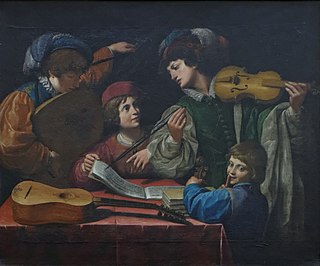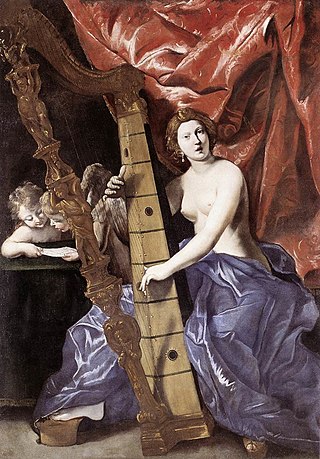
Il Sodoma was the name given to the Italian Renaissance painter Giovanni Antonio Bazzi. Il Sodoma painted in a manner that superimposed the High Renaissance style of early 16th-century Rome onto the traditions of the provincial Sienese school; he spent the bulk of his professional life in Siena, with two periods in Rome.

Carlo Saraceni was an Italian early-Baroque painter, whose reputation as a "first-class painter of the second rank" was improved with the publication of a modern monograph in 1968.

The Galleria Nazionale d'Arte Antica or National Gallery of Ancient Art is an art museum in Rome, Italy. It is the principal national collection of older paintings in Rome – mostly from before 1800; it does not hold any antiquities. It has two sites: the Palazzo Barberini and the Palazzo Corsini.

Giovanni Lanfranco was an Italian painter of the Baroque period.

The Palazzo Barberini is a 17th-century palace in Rome, facing the Piazza Barberini in Rione Trevi. Today, it houses the Galleria Nazionale d'Arte Antica, the main national collection of older paintings in Rome.

Antonio di Benedetto Aquilo degli Aquili, known as Antoniazzo Romano, was an Italian Early Renaissance painter, the leading figure of the Roman school during the latter part of the 15th century. He "made a speciality of repainting or interpreting older images, or generating new cult images with an archaic flavor", in particular by very often using the gold ground style, which was unusual by this period.

Saint Francis in Prayer is a painting from the Italian master Caravaggio, in the Galleria Nazionale d'Arte Antica in Rome.

Leonello Spada was an Italian painter of the Baroque period, active in Rome and his native city of Bologna, where he became known as one of the followers of Caravaggio.

Francesco Cozza was an Italian painter of the Baroque period.

Santi Giovanni e Petronio dei Bolognesi is a Roman Catholic church in central Rome, Italy. It is named after the Saints John the Evangelist and Petronius, who are patrons of the city of Bologna. This church was made the "national church" of the Bolognese in Rome in 1581, by order of Pope Gregory XIII. It is located in the Rione of Regola, on Via del Mascherone, across the street and just south of the Gardens behind the Palazzo Farnese. It is today the "regional church" of Emilia-Romagna.

Giuseppe Bartolomeo Chiari, also known simply as Giuseppe Chiari, was an Italian painter of the late-Baroque period, active mostly in Rome.

Tommaso Donini or Tommaso Dovini, called Il Caravaggino was an Italian painter active mainly in Rome. He was previously erroneously referred to as 'Tommaso Luini' as the 17th century artist biographer Giovanni Baglione referred to him as such in his Le Vite de’ Pittori of 1642. Donini painted altarpieces. He was a follower of Caravaggio.

The Palazzo Corsini is a prominent late-baroque palace in Rome, erected for the Corsini family between 1730 and 1740 as an elaboration of the prior building on the site, a 15th-century villa of the Riario family, based on designs of Ferdinando Fuga. It is located in the Trastevere section of the city, and stands beside the Villa Farnesina.

Ettore Tito was an Italian artist particularly known for his paintings of contemporary life and landscapes in Venice and the surrounding region. He trained at the Accademia di Belle Arti in Venice and from 1894 to 1927 was the Professor of Painting there. Tito exhibited widely and was awarded the Grand Prize in painting at the 1915 Panama–Pacific International Exposition in San Francisco. In 1926 he was made a member of the Royal Academy of Italy. Tito was born in Castellammare di Stabia in the province of Naples and died in Venice, the city which was his home for most of his life.

Francesco Podesti was an Italian painter, active in a Romantic style. Together with Francesco Hayez and Giuseppe Bezzuoli, he is considered one of the greatest Italian painters of the first half of the 19th century. He was prolific in his large canvases on historical subjects. He is best known for his fresco work, including those in the Hall of the Immacolata in the Vatican Museum.
Giovanni Domenico Piastrini (1678–1740) was an Italian painter of the Baroque period, active in Tuscany and Rome.

Venus plays the Harp is a painting by the Italian Baroque painter Giovanni Lanfranco. It is housed in the Galleria Nazionale d'Arte Antica at Palazzo Barberini, Rome.



















